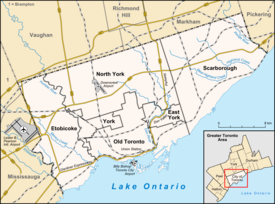Kensington Market
| Kensington Market | |
|---|---|
| Neighbourhood | |

Shops in Kensington Market
|
|
 |
|
| Location within Toronto | |
| Coordinates: 43°39′17.18″N 79°24′02.44″W / 43.6547722°N 79.4006778°WCoordinates: 43°39′17.18″N 79°24′02.44″W / 43.6547722°N 79.4006778°W | |
| Country |
|
| Province |
|
| City |
|
| Government | |
| • MP | Adam Vaughan (Trinity—Spadina) |
| • MPP | Han Dong (Trinity—Spadina) |
| • Councillor | Joe Cressy (Ward 20 Trinity—Spadina) |
| Designated | 2006 |
Kensington Market is a distinctive multicultural neighbourhood in Downtown Toronto, Ontario, Canada. The Market is an older neighbourhood and one of the city's most well-known. In November 2006, it was designated a National Historic Site of Canada.Robert Fulford wrote in 1999 that "Kensington today is as much a legend as a district. The (partly) outdoor market has probably been photographed more often than any other site in Toronto."
Its approximate borders are College St. on the north, Spadina Ave. on the east, Dundas St. W. to the south, and Bathurst St. to the west. Most of the neighbourhood's eclectic shops, cafes, and other attractions are located along Augusta Ave. and neighbouring Nassau St., Baldwin St., and Kensington Ave. In addition to the Market, the neighbourhood features many Victorian homes, the Kensington Community School and Toronto Western Hospital.
George Taylor Denison, after serving in the British militia during the War of 1812, purchased an area of land in 1815 from Queen Street West to Bloor Street, roughly between where Augusta and Lippincott Streets now run. Denison used the area now known as Bellevue Square Park as a parade ground for his volunteer cavalry troop, which he commanded during the Upper Canada Rebellion. This troop later became the Governor General's Horse Guards. The Denison estate was subdivided in the 1850s. During the 1880s, houses were built on small plots for Irish and Scottish immigrant labourers coming to Toronto; much of the housing is in the style of Victorian architecture row houses, which are moderate in size and exemplify true Victorian architecture. Many of these houses still stand along Wales Avenue and elsewhere, and these homes have been inhabited by many waves of immigrants in the decades that followed. Housing found closer to the market area tends to feature retail at the front of the house.
...
Wikipedia

